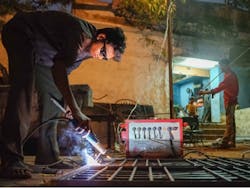Minigrids and distributed renewable energy (DRE) promise to create much-needed employment as rural electrification ramps up in Nigeria, India and Kenya, according to a study, Powering Jobs Census 2019: The Energy Access Workforce.
The report comes from Power for All, an organization of 250 business, finance, research and civil society organizations, working to provide electricity to underserved nations.
In Nigeria potential exists to create more than 52,000 direct, formal jobs, 50,000 of which would serve 405 MW worth of minigrid systems in 2022, said the report.
Workers in Kamalapuram, India. Photo by Paul Prescott/Shutterstock.com
Minigrid development in Kenya has the potential to yield 5,000 jobs in 2022, up from the current 260 jobs.
And in India, electrification efforts are expected to boost minigrid output from the current 3.5 MW to 500 MW by 2020, yielding more than 90,000 jobs. Total off-grid solar potential in India is estimated to be a whopping 64.7 GW in 2022.
Double punch from electrification
In addition to green minigrids, distributed renewable energy includes solar for homes and businesses and machinery for productive use such as irrigation pumps. Electrification from these resources will provide a double punch, not only creating jobs but supplying opportunities for economic growth because the electricity can be used for productive purposes. This creates a “virtuous cycle,” allowing citizens to move up the economic ladder, the report said.
The trend identified in the report has already taken hold in some countries. In India, distributed renewable energy companies already directly employ 95,000 people — as many workers as the traditional utility-scale power sector. And that number is expected to more than double by 2022-23.
Huge job creation opportunity — if governments support the ability of local people to build skills.
Not only does distributed renewable energy have the potential to yield direct, formal jobs in these countries, but it also can yield up to five times as many jobs created through the productive use of energy — crop irrigation, for example. These jobs are being created in rural communities that could take advantage of being electrified for the first time.
Schneider Electric Foundation, one of the report’s underwriters, has committed to training 1 million underprivileged people in energy management by 2025. In announcing the report, Schneider described a huge job creation opportunity, but says it is contingent upon government supporting the ability of local people to build skills and capacity.
Job count beats traditional power sector
In the three countries, the number of jobs in the distributed renewable energy sector are already above or approaching the number of jobs in more traditional power sectors, the report said.
In Kenya, that’s 10,000 jobs compared to 11,000 from the national utility. And in Nigeria, the distributed renewable energy sector employs 4,000 people compared to 10,000 in the electricity, gas, steam and air conditioning sector.
“By 2022–23, the direct, formal workforce could grow 100% in India, 70% in Kenya and more than 10 fold in Nigeria, reaching 190,000, 17,000 and 52,000 jobs respectively,” said the report,
According to the report, direct, formal jobs are created through contracts with incorporated companies in the sector. These might include information technology professionals or project managers employed by a distributed renewable energy company.
The informal sector jobs refers to work for unincorporated companies and can include the work of family members, said the report.
By 2030, the entire DRE value chain is projected to create 4.5 million jobs globally.
It appears that employees like these green jobs. Thesector retains employees longer than the more traditional power sectors, said the report. And the average pay rate is about middle-income for each country.
But an obstacle…
One obstacle: potential employees need to learn skills that are necessary to ensure the distributed renewable energy sector thrives. This creates an opportunity for governments, universities, training organizations and industry associations to work together.
“Managerial skills in particular are in high demand, being identified as the most difficult to recruit. Technical skills are also needed in sales, distribution, and operations,” said the report. Financial support needs to go to the institutions in local markets to provide curricula, equipment, trainers and standardized evaluation of training programs, the report said.
Overall, developing the sector is a powerful way to create jobs, employ people who often are underemployed and reap environmental benefits, said the report.
“The impact potential is enormous: today, there are an estimated 370,000 jobs in the off-grid lighting sector in Asia alone. By 2030, the entire DRE value chain — including sales, installation, service, appliances, and operations and maintenance — is projected to create 4.5 million jobs globally,” said the report.
Supported by the Schneider Electric Foundation and The Rockefeller Foundation, the report is expected to be the first of many that will be released covering 25 countries by 2021.
Track news about jobs from minigrids and other distributed energy resources. Subscribe to the free Microgrid Knowledge newsletter.








